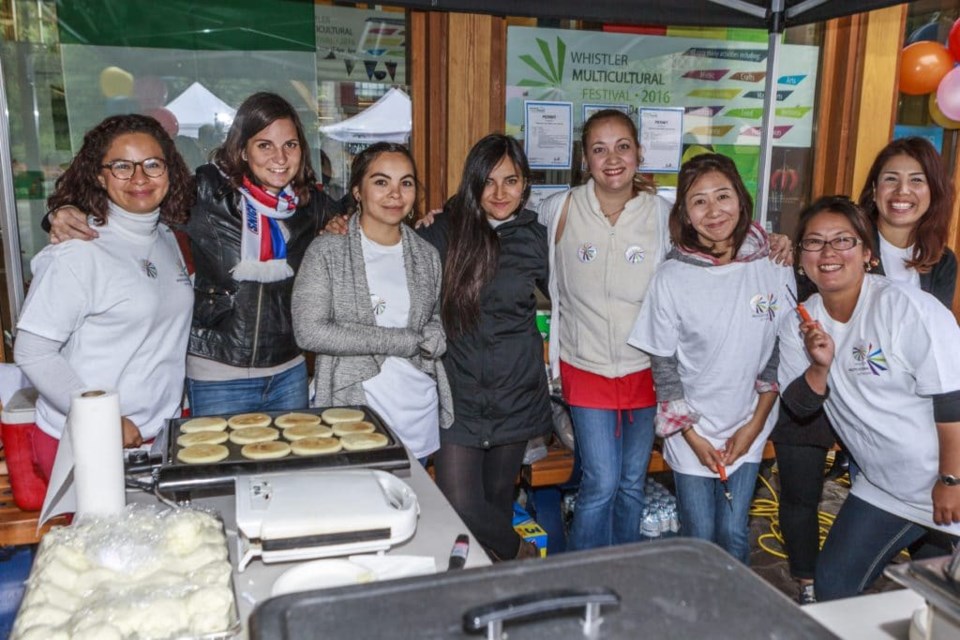Given its status as an international tourism destination, Whistler has for years been a natural landing spot for foreigners from across the globe. Now, thanks to recently compiled data from the Whistler Multicultural Society (WMS), we can see that trend has only escalated over the past five years, even as the COVID-19 pandemic closed international borders and tourism jobs dried up.
Pulling together recently released census data, along with municipal demographic statistics from across the Sea to Sky, the WMS last week released an infographic showing diversity levels in the corridor.
Notably for Whistler, the resort’s immigrant community—which totalled 3,320 in the 2021 census—now makes up nearly a quarter of the permanent population, at 23.7 per cent, up three percentage points from the 2016 census. That’s the highest proportion of immigrants—considered a landed immigrant or permanent resident—of any Sea to Sky community, with Squamish counting a fifth of its population as immigrants; the Squamish-Lillooet Regional District at 19.2 per cent; and the Sunshine Coast at 18.2 per cent.
The number of non-permanent residents in Whistler—largely made up of temporary foreign workers and their families—is on the rise as well. Even with the pandemic’s effects on the local job market, the number of non-permanent residents grew nearly 18 per cent, from 1,185 in 2016 to 1,395 last year.
“I think that’s the case because of the economic possibilities in Whistler,” said Kira Grachev, community outreach coordinator with the WMS.
Concerns around the lack of housing and unaffordability haven’t dampened Whistler’s potential as a landing spot for foreign workers, explained Joel Chevalier, owner and founder of Whistler-based recruitment firm, Culinary Recruitment International, but the multitude of job opportunities elsewhere in the country means workers—and, particularly, skilled workers—don’t stay on the market for long.
“I have three different employers in their hiring phase and every week that goes by that they don’t make a decision, applicants are telling me they’ve got other offers and they’ll move somewhere else,” he said. “The trend is it’s an employee’s market and even employees coming from less economically strong countries still have lots of opportunities.”
While Whistler counts a high proportion of immigrants compared to its Sea to Sky neighbours, it still lags behind British Columbia and Canada when it comes to visible minorities. As of the 2021 census, 12.2 per cent of Whistler identified as a visible minority, an increase from 10.3 per cent five years prior, but still well below B.C. (34.4 per cent) and Canada (26.5 per cent).
In 2021, Filipino, Japanese and Chinese were the top three visible minorities identified in Whistler, followed by Latin American, South Asian, Southeast Asian, and Black. The most common mother tongues (other than English and French) of clients accessing the WMS are Tagalog, Japanese, Spanish and Czech.
Grachev believes that low proportion of visible minorities speaks to several factors, namely, the steep financial cost to get into skiing, as well as the sport’s Eurocentric roots.
“Definitely there’s a class question here,” she noted.
On top of that is the “layer of invisibility” to Whistler’s visible minority community that the WMS is trying to cut through.
“While you can see that visible minorities in Whistler are increasing, in what way are we all integrating into the community?” Grachev said. “That’s the real question, and if you live in Whistler, you can see quite clearly … that there is a little bit of unintended or indirect segregation of all the different populations here, and specifically immigrants. They are often working late shifts, overnight in hotels, or underground and behind the scenes.”
Beyond the language and cultural barriers newly landed immigrants can face in Whistler, there’s also the difficulty of navigating essential services, such as banking, housing and health-care.
“If you don’t know your rights, you don’t even know you’re in a wrongful situation. You may think it’s normal and have to endure this hardship,” said Izumi Inoue, outreach worker for the Whistler Community Services Society (WCSS).
Increasingly, it’s resort employers taking on the responsibility of connecting foreign employees to local resources, today a normal component of running a business in Whistler.
“When we first started bringing in a different cultural mix—I remember when we first started bringing in Moroccans and now we’re bringing in people from Cameroon and Senegal—employers weren’t quite sure what they were supposed to do and how to do it. Now they know it’s part of that connection,” Chevalier said. “You don’t always get it right, but employees notice the difference, and quite honestly, if you’re bringing someone here, it’s your responsibility to make them feel welcome.”
The WMS is finalizing its Sea to Sky Racism, Discrimination and Bias report, based on community surveys, expected for completion by the new year. Grachev said one notable trend from the results was the identified lack of a formal outlet for anyone who may have experienced racism or discrimination locally.




